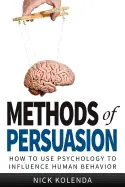
Methods of Persuasion - by Nick Kolenda
ISBN: 0615815650Date read: 2024-02-14
How strongly I recommend it: 1/10
(See my list of 430+ books, for more.)
Go to the Amazon page for details and reviews.
If you hadn’t already read all its pop psychology references, this might be interesting. But unfortunately I already recognized every reference, so I had to stop reading halfway through.
my notes
Perception is a lens through which we interpret reality.
Altering that lens changes how people view and interpret reality.
Schemas:
For any general concept, you usually associate many other ideas with that concept.
If that set of associations - known as a schema - becomes activated, it can alter your perception and behavior because it would make the other associated concepts more prevalent in your mind.
Prime a schema by merely exposing people to certain words or ideas related to a particular schema.
Why does a “lucky dwarf” activate the idea of seven?
It combines two other ideas that are heavily associated with seven:
“lucky number seven”
and Snow White and the Seven Dwarves.
Words merely relating to open-mindedness (e.g., flexible, elastic, rubber, change) have been found to trigger more open-minded perceptions.
To activate an open-minded perception, you simply need to expose your target to an example of open-mindedness, such as a story of someone who recently tried a new experience and enjoyed it.
Remember how you told me that I should start listening to the band, Mumford & Sons?
I didn’t like them at first, but I listened to them again, and I really like them now.
A conversation about someone complying with a request? Words relating to helpfulness.
If you prime someone’s schema for birthday, you’re likely to trigger behavior associated with gift giving.
Whenever you’re trying to persuade someone, brainstorm a possible schema that you can activate.
When we use anchors as a shortcut for our decision making, we usually fail to achieve our primary goal of forming an accurate judgment.
Because we often adjust from an anchor point until we reach the outermost estimate within a range of plausible judgments.
Ebbinghaus illusion: contrast effect, the tendency to perceive a stimulus differently depending on the surrounding stimuli.
Perceptual contrast:
not only with arbitrary circles but with many different types of stimuli each day.
Unhealthy meal or an organic fruit salad?
When someone is forming a judgment, an anchor that is very extreme will trigger a contrast effect.
People who were primed to think of a decadent cheesecake adjusted their calorie estimate of a cheeseburger away from the high end. The cheeseburger became seemingly smaller because the very unhealthy cheesecake made the number of calories in a cheeseburger seem fewer.
When judges evaluate a homicide case, they tend to perceive subsequent cases to be less severe.
Offer a numeric anchor that’s higher than average?
That higher number would become an anchor point that your customers would assimilate toward, leading to a larger purchase than they would typically buy.
Product A:
Online subscription for $59.
Product B–:
Print subscription for $125.
Product B:
Online and print subscription for $125.
If you present those options to people, you’d be hard-pressed to find even one person who would choose Product B–.
The product marked as “B–”: its mere presence drastically changed the outcome.
Percentage of people choosing the online only subscription dropped from 68 percent to 16 percent.
Percentage of people choosing the online and print subscription (a more expensive option) increased from 32 percent to 84 percent.
Due to contrast effects, Product B became a seemingly better option because people could compare it to Product B–.
When we expect a certain event, our brain often molds our perception of that event to match our expectations.
We see what we expect to see.
We hear what we expect to hear.
We feel what we expect to feel.
Placebo effects:
People found the taste of wine more pleasing when they merely believed it was purchased at a higher price.
Convey high expectations because those expectations will become a lens that will mold their perception.